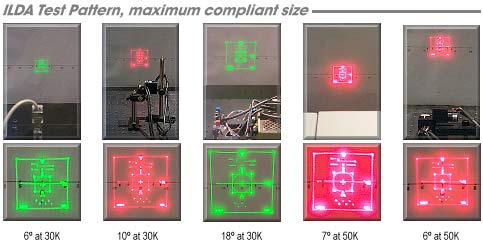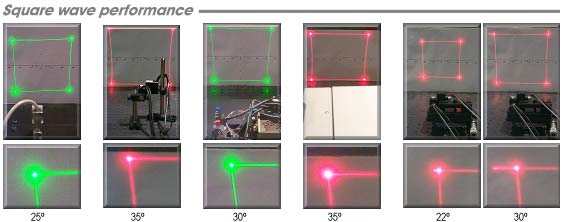![]()

This
page
|
T |
he photos below show how different
scanners perform when displaying test patterns. To see enlarged views of any
photo button, just click on the button. A separate page has photos showing how these scanners perform when displaying sample images taken from the Lightspeed "Creation" show. Click here to see the Creation photos. |
| T | hese photos show the maximum
angle at which a scanner can correctly reproduce the ILDA Test
Pattern,
at a given speed. The larger the angle, the better. For the three ILDA 30K-tuned scanners, there are clear performance differences. The Cambridge 6800 can correctly scan the ILDA Test Pattern at a much larger angle than the GS G-120 with TurboTrack 2 scanner amps. In turn, the GS/TurboTrack combination can scan at a larger angle than the Catweazle. For faster scanners, the Cambridge 6800 using Pangolin TrueK 50 and the Cambridge 6210 are roughly equal in performance.
|
|
|
T | hese photos show the ILDA Test
Pattern at a 30 degree optical scan angle. In all cases, the
circle-in-the-square test will not work -- the circle will be well inside
the square. This means that none of these scanners correctly shows the
ILDA Test Pattern at 30 degrees. However, these photos do show how well
the scanners can show other aspects of the test pattern. The Catweazle exhibits slight rounding, compared with the two other 30K-tuned scanners. Both of the fast scanners have trouble with the image. It cannot be shown at 30 degrees without overheating the scanner. As a result, the TrueK 50 amp power limits all of the X-axis scanner's signal. This is why the TrueK 50 pattern is narrower. The Cambridge 6210 takes a different approach. It power limits only part of the X-axis scanner's signals. This is why the "X" and "ILDA" parts of the test pattern are reduced towards the center -- these are the parts that are most troublesome. |
|
T | hese final pictures show a
square
wave test pattern at around 30 degrees. The scanner is jumping as fast as
possible, over a very large angle. Ideally, you should see a dot at each
corner. There should be little or no overshoot. This is achieved by all the scanner tunings here, except for the Cambridge 6210. It exhibits overshoot beginning at 22 degrees. By 30 degrees the overshoot is severe -- about 3 degrees, or 10%, in the X axis.
|


